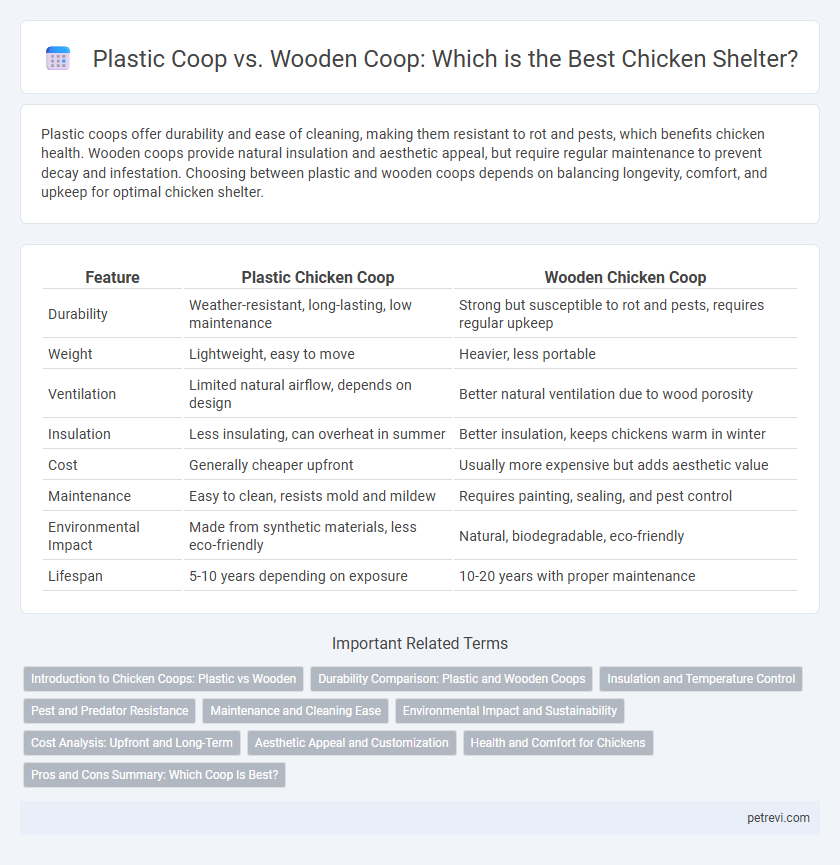Plastic coops offer durability and ease of cleaning, making them resistant to rot and pests, which benefits chicken health. Wooden coops provide natural insulation and aesthetic appeal, but require regular maintenance to prevent decay and infestation. Choosing between plastic and wooden coops depends on balancing longevity, comfort, and upkeep for optimal chicken shelter.
Table of Comparison
| Feature | Plastic Chicken Coop | Wooden Chicken Coop |
|---|---|---|
| Durability | Weather-resistant, long-lasting, low maintenance | Strong but susceptible to rot and pests, requires regular upkeep |
| Weight | Lightweight, easy to move | Heavier, less portable |
| Ventilation | Limited natural airflow, depends on design | Better natural ventilation due to wood porosity |
| Insulation | Less insulating, can overheat in summer | Better insulation, keeps chickens warm in winter |
| Cost | Generally cheaper upfront | Usually more expensive but adds aesthetic value |
| Maintenance | Easy to clean, resists mold and mildew | Requires painting, sealing, and pest control |
| Environmental Impact | Made from synthetic materials, less eco-friendly | Natural, biodegradable, eco-friendly |
| Lifespan | 5-10 years depending on exposure | 10-20 years with proper maintenance |
Introduction to Chicken Coops: Plastic vs Wooden
Plastic chicken coops offer lightweight, durable, and weather-resistant shelter that requires minimal maintenance compared to traditional wooden coops. Wooden coops provide natural insulation and aesthetic appeal but can be prone to rot, pests, and require regular treatment to maintain longevity. Choosing between plastic and wooden chicken coops depends on factors such as climate conditions, budget, and desired durability for optimal chicken protection.
Durability Comparison: Plastic and Wooden Coops
Plastic chicken coops offer superior resistance to weather elements, moisture, and pests, ensuring longer-lasting durability with minimal maintenance compared to wooden coops. Wooden coops, while aesthetically pleasing and better insulated, are prone to rot, termite damage, and warping over time, requiring regular treatment and repairs to maintain structural integrity. The inherent waterproof and non-porous properties of plastic materials make plastic coops a more durable and low-maintenance option for long-term chicken shelter solutions.
Insulation and Temperature Control
Plastic coops offer superior insulation by effectively trapping heat, maintaining stable temperatures even in cold weather, thus providing a comfortable environment for chickens. Wooden coops, while natural and breathable, often require additional insulation to prevent heat loss and temperature fluctuations during extreme weather conditions. Proper insulation in both coop types is crucial to regulate temperature and protect chickens from stress-related health issues caused by temperature extremes.
Pest and Predator Resistance
Plastic coops offer superior resistance to pests and predators due to their solid construction and non-porous surfaces, which prevent termites and rodents from burrowing or nesting. Wooden coops, while traditional, are more vulnerable to infestations from ants, termites, and potential predator damage such as claw marks or chewing. For enhanced chicken safety, plastic coops provide a durable, low-maintenance shelter that minimizes pest and predator risks.
Maintenance and Cleaning Ease
Plastic coops offer superior ease of maintenance and cleaning compared to wooden coops, as their smooth, non-porous surfaces resist dirt, moisture, and bacteria buildup. Unlike wood, plastic does not absorb moisture, preventing mold and rot, and can be quickly washed down with a hose or disinfectant without damage. While wooden coops may require regular sealing, sanding, and repairs, plastic coops minimize labor and provide a more hygienic environment for chickens.
Environmental Impact and Sustainability
Plastic coops often involve petroleum-based materials that contribute to long-term environmental pollution and pose recycling challenges, whereas wooden coops are biodegradable and sourced from renewable timber, promoting sustainability. Wood's natural insulating properties reduce energy consumption for temperature regulation, enhancing eco-friendliness compared to plastic alternatives. The durability and repairability of wooden coops lower replacement frequency and waste generation, aligning with sustainable farming practices.
Cost Analysis: Upfront and Long-Term
Plastic coops generally have a higher upfront cost than wooden coops due to material durability and weather resistance, but require less frequent maintenance and repairs, reducing long-term expenses significantly. Wooden coops tend to be cheaper initially but incur ongoing costs from rot, pests, and weather damage that increase upkeep and replacement investments over time. Choosing between plastic and wooden chicken coops involves balancing initial budget constraints against projected maintenance and replacement costs to ensure cost-effective sheltering.
Aesthetic Appeal and Customization
Plastic coops offer sleek, modern designs with vibrant colors that withstand weather without fading, enhancing the aesthetic appeal in contemporary garden setups. Wooden coops provide a rustic, natural look that can be easily customized with paint, stains, or decorative features, allowing for personalized styles and integration into traditional outdoor environments. Customization potential is higher in wooden coops due to their malleability, while plastic coops excel in durability and low-maintenance finishes.
Health and Comfort for Chickens
Plastic coops provide better insulation and are easier to clean, reducing the risk of bacterial buildup and promoting healthier living conditions for chickens. Wooden coops offer natural breathability, which helps regulate humidity and temperature, enhancing comfort and reducing respiratory issues. Choosing between plastic and wooden coops depends on balancing sanitation ease with ventilation needs to maintain optimal chicken health and comfort.
Pros and Cons Summary: Which Coop Is Best?
Plastic chicken coops offer durability, easy cleaning, and resistance to pests, making them low-maintenance and weather-resistant options ideal for wet climates. Wooden coops provide better insulation, natural breathability, and a more traditional aesthetic but require regular maintenance to prevent rot, pests, and weather damage. The best coop depends on prioritizing durability and ease of cleaning with plastic versus natural insulation and appearance with wood.
Plastic Coop vs Wooden Coop for Chicken Shelter Infographic

 petrevi.com
petrevi.com